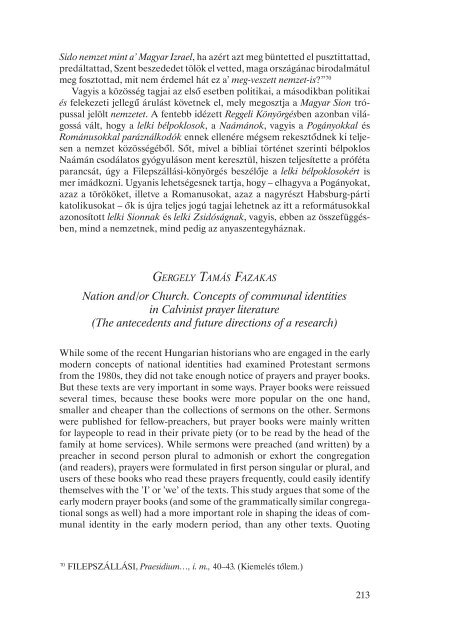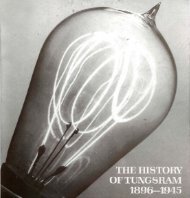Humanizmus, religio, identitástudat - MEK - Országos Széchényi ...
Humanizmus, religio, identitástudat - MEK - Országos Széchényi ...
Humanizmus, religio, identitástudat - MEK - Országos Széchényi ...
You also want an ePaper? Increase the reach of your titles
YUMPU automatically turns print PDFs into web optimized ePapers that Google loves.
Sido nemzet mint a’ Magyar Izrael, ha azért azt meg büntetted el pusztittattad,<br />
predáltattad, Szent beszededet tölök el vetted, maga országánac birodalmátul<br />
meg fosztottad, mit nem érdemel hát ez a’ meg-veszett nemzet-is?” 70<br />
Vagyis a közösség tagjai az első esetben politikai, a másodikban politikai<br />
és felekezeti jellegű árulást követnek el, mely megosztja a Magyar Sion trópussal<br />
jelölt nemzetet. A fentebb idézett Reggeli Könyörgésben azonban világossá<br />
vált, hogy a lelki bélpoklosok, a Naámánok, vagyis a Pogányokkal és<br />
Románusokkal paráználkodók ennek ellenére mégsem rekesztődnek ki teljesen<br />
a nemzet közösségéből. Sőt, mivel a bibliai történet szerinti bélpoklos<br />
Naámán csodálatos gyógyuláson ment keresztül, hiszen teljesítette a próféta<br />
parancsát, úgy a Filepszállási-könyörgés beszélője a lelki bélpoklosokért is<br />
mer imádkozni. Ugyanis lehetségesnek tartja, hogy – elhagyva a Pogányokat,<br />
azaz a törököket, illetve a Romanusokat, azaz a nagyrészt Habsburg-párti<br />
katolikusokat – ők is újra teljes jogú tagjai lehetnek az itt a reformátusokkal<br />
azonosított lelki Sionnak és lelki Zsidóságnak, vagyis, ebben az összefüggésben,<br />
mind a nemzetnek, mind pedig az anyaszentegyháznak.<br />
GERGELY TAMÁS FAZAK AS<br />
Nation and/or Church. Concepts of communal identities<br />
in Calvinist prayer literature<br />
(The antecedents and future directions of a research)<br />
While some of the recent Hungarian historians who are engaged in the early<br />
modern concepts of national identities had examined Protestant sermons<br />
from the 1980s, they did not take enough notice of prayers and prayer books.<br />
But these texts are very important in some ways. Prayer books were reissued<br />
several times, because these books were more popular on the one hand,<br />
smaller and cheaper than the collections of sermons on the other. Sermons<br />
were published for fellow-preachers, but prayer books were mainly written<br />
for laypeople to read in their private piety (or to be read by the head of the<br />
family at home services). While sermons were preached (and written) by a<br />
preacher in second person plural to admonish or exhort the congregation<br />
(and readers), prayers were formulated in first person singular or plural, and<br />
users of these books who read these prayers frequently, could easily identify<br />
themselves with the ’I’ or ’we’ of the texts. This study argues that some of the<br />
early modern prayer books (and some of the grammatically similar congregational<br />
songs as well) had a more important role in shaping the ideas of communal<br />
identity in the early modern period, than any other texts. Quoting<br />
70<br />
FILEPSZÁLLÁSI, Praesidium…, i. m., 40–43. (Kiemelés tőlem.)<br />
213








![Letöltés egy fájlban [4.3 MB - PDF]](https://img.yumpu.com/50159926/1/180x260/letaltacs-egy-fajlban-43-mb-pdf.jpg?quality=85)








